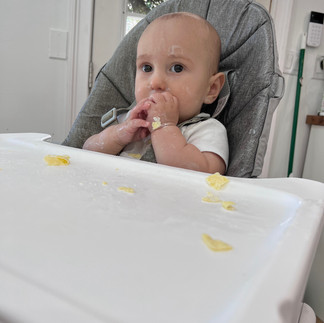A flexible approach to Baby Led Weaning
- Nicole Wernert
- Jul 20, 2023
- 4 min read
Updated: Aug 17, 2023
As a speech language pathologist who has worked with children on their feeding goals, I've researched the different methods of introducing foods. What I've found is there is no one way fits all! The journey of introducing solid foods to your baby is an exciting milestone filled with joy, curiosity, and some uncertainty. For me introducing foods to my son was much anticipated.
As parents, we are often bombarded with various feeding approaches, leaving us wondering if we have to choose between baby-led weaning or starting with purees. In this blog post, we will explore the benefits of both methods and discuss how embracing choice and flexibility can lead to a positive and personalized weaning experience for you and your little one.
Baby-led weaning (BLW) is a method that encourages babies to self-feed and explore solid foods at their pace. It empowers your little one to engage with various textures, tastes, and shapes, fostering independence and self-regulation from an early age. BLW allows babies to be in control of their eating experiences, which can promote healthy eating habits and a positive relationship with food. On the other hand, starting with purees offers a controlled and gradual introduction to solid foods. Purees allow you to control the texture and consistency, making it easier for babies to swallow and digest. It also enables parents to introduce a variety of flavors and nutrients in a more structured manner, which can be reassuring for those who are concerned about potential choking hazards or allergies.
So often I feel that in social media it's portrayed as one or the other but I asked myself why not both?
The beauty of the weaning journey is that you don't have to pick just one method. Many parents choose to combine baby-led weaning and purees, creating a flexible and balanced approach that best suits their baby's needs. Starting with purees can help establish a solid foundation for oral motor skills and gradual food introduction, while baby-led weaning can empower your child to develop self-feeding abilities and explore new tastes and textures. Every baby is unique, and their readiness for solid foods may vary. Instead of feeling pressured to choose between the two methods, it's essential to observe your baby's cues and signals. Some babies may show an eagerness to self-feed, while others may prefer starting with smoother textures. Being flexible and responsive to your baby's cues allows you to tailor the weaning journey to their individual needs and comfort level.
My son grabbed for utensils from the very beginning which encouraged me to continue giving him the option to use them himself. He would dive headfirst into whatever foods were in front of him as early as 4 months old. What he wasn't able to do at 4 months was sit unassisted; which is an important milestone before beginning to expose him to whole foods. I also consulted with our pediatrician at our 4 month appointment and she felt we were a few months away from introducing foods that would require more advanced oral motor skills. This is why we decided to introduced purees with an emphasis on self-feeding and sensory exploration.
Combining baby-led weaning and starting with purees can offer a balanced approach to introducing solid foods. You can begin with purees to introduce essential nutrients, temperatures and flavors, then gradually transition to solids as your baby's motor skills and posture develop. This balanced approach can give you the best of both worlds, ensuring your baby begins to develop a relationship with self-feeding while encouraging them to explore and enjoy mealtime independently.
When it comes to baby-led weaning vs. starting with purees, there is no one-size-fits-all answer. Embracing choice and flexibility allows you to create a weaning experience that aligns with your baby's developmental stage, readiness, and individual preferences. Whether you choose one method exclusively or opt for a combination of both, the key is to foster a positive and enjoyable feeding journey that encourages independence and healthy eating habits. Remember, there is no right or wrong way – trust your instincts as a parent and embrace the joy of witnessing your little one explore the world of solid foods!
Regardless of whether you choose to start with purees, baby-led weaning, or a combination of both, it's essential to emphasize the significance of family mealtime. Sharing meals together not only strengthens the bond between family members but also creates a positive environment for your baby to learn about eating habits, table manners, and social interactions. Family mealtime sets the stage for fostering healthy relationships with food and encourages your child to be an adventurous eater. By making family meals a priority, you are instilling lifelong values of togetherness, communication, and nourishment, enriching your little one's growth and development beyond just their eating habits. Remember, the joy and connection shared around the dinner table make for unforgettable memories that will be cherished for years to come.
Enjoy this time with your child and start making memories, even if they're very messy memories!


































Comments